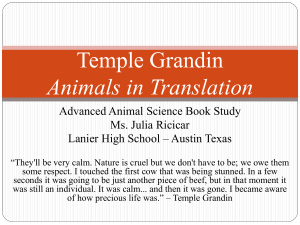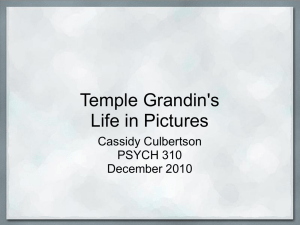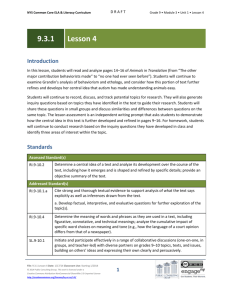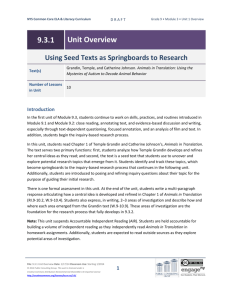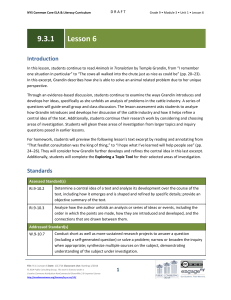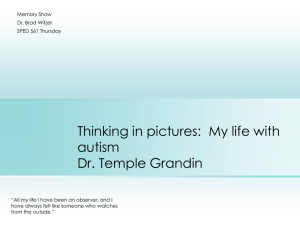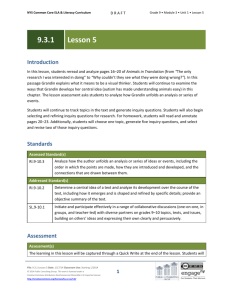Grade 9 ELA Module 3, Unit 1, Lesson 7
advertisement
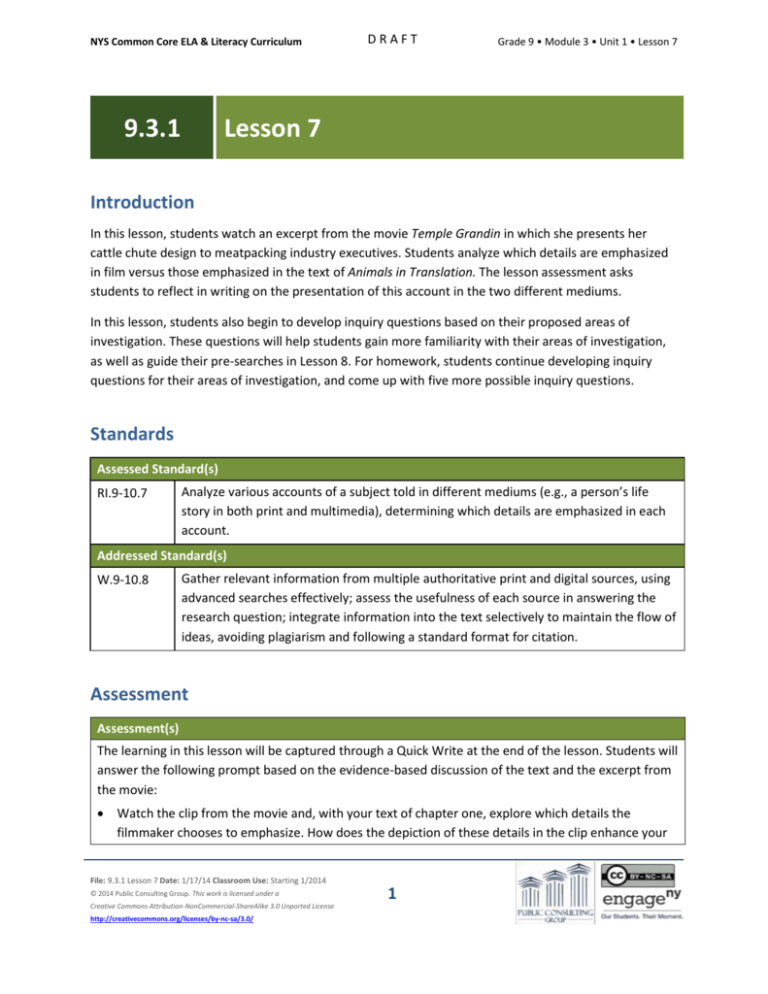
NYS Common Core ELA & Literacy Curriculum 9.3.1 DRAFT Grade 9 • Module 3 • Unit 1 • Lesson 7 Lesson 7 Introduction In this lesson, students watch an excerpt from the movie Temple Grandin in which she presents her cattle chute design to meatpacking industry executives. Students analyze which details are emphasized in film versus those emphasized in the text of Animals in Translation. The lesson assessment asks students to reflect in writing on the presentation of this account in the two different mediums. In this lesson, students also begin to develop inquiry questions based on their proposed areas of investigation. These questions will help students gain more familiarity with their areas of investigation, as well as guide their pre-searches in Lesson 8. For homework, students continue developing inquiry questions for their areas of investigation, and come up with five more possible inquiry questions. Standards Assessed Standard(s) RI.9-10.7 Analyze various accounts of a subject told in different mediums (e.g., a person’s life story in both print and multimedia), determining which details are emphasized in each account. Addressed Standard(s) W.9-10.8 Gather relevant information from multiple authoritative print and digital sources, using advanced searches effectively; assess the usefulness of each source in answering the research question; integrate information into the text selectively to maintain the flow of ideas, avoiding plagiarism and following a standard format for citation. Assessment Assessment(s) The learning in this lesson will be captured through a Quick Write at the end of the lesson. Students will answer the following prompt based on the evidence-based discussion of the text and the excerpt from the movie: Watch the clip from the movie and, with your text of chapter one, explore which details the filmmaker chooses to emphasize. How does the depiction of these details in the clip enhance your File: 9.3.1 Lesson 7 Date: 1/17/14 Classroom Use: Starting 1/2014 © 2014 Public Consulting Group. This work is licensed under a Creative Commons Attribution-NonCommercial-ShareAlike 3.0 Unported License http://creativecommons.org/licenses/by-nc-sa/3.0/ 1 NYS Common Core ELA & Literacy Curriculum DRAFT Grade 9 • Module 3 • Unit 1 • Lesson 7 understanding? What is absent that you would want to see to understand more? This assessment will be evaluated using the Short Response Rubric. High Performance Response(s) A high performance response may include the following: In the clip from the movie Temple Grandin, the filmmaker chooses to emphasize people’s distrust in Grandin’s design system and the challenges she faced going into the meatpacking industry. The clip also highlights Grandin’s ability to argue for her design and prove to her superiors that her ideas are well thought out. Finally, the clip highlights Grandin’s visual thinking, how she sees her system in her head. She knows the animals will be calmer in it: “I know my system will work,” she says, “because I’ve been through it a thousand times in my head.” This depiction enhanced my understanding by allowing me to see her designs in action and to see an actress speak the way Temple Grandin does. I would want to see how she came up with the idea, and what it looks like in her head. Maybe that's in the part of the movie we didn’t watch. Vocabulary Vocabulary to provide directly (will not include extended instruction) accounts (n.) – reports or descriptions of an event mediums (n.) – the means by which something is communicated or expressed depiction (n.) – a representation in a drawing, painting, or another art form implications (n.) – conclusions that can be drawn from something, although they are not explicitly stated Vocabulary to teach (may include direct word work and/or questions) None. Lesson Agenda/Overview Student-Facing Agenda % of Lesson Standards & Text: Standards: RI.9-10.7, W.9-10.8 Text: Animals in Translation, Chapter 1 Learning Sequence: 1. Introduction of Lesson Agenda 1. 10% File: 9.3.1 Lesson 7 Date: 1/17/14 Classroom Use: Starting 1/2014 © 2014 Public Consulting Group. This work is licensed under a Creative Commons Attribution-NonCommercial-ShareAlike 3.0 Unported License http://creativecommons.org/licenses/by-nc-sa/3.0/ 2 NYS Common Core ELA & Literacy Curriculum 2. 3. 4. 5. 6. DRAFT Grade 9 • Module 3 • Unit 1 • Lesson 7 Homework Accountability Temple Grandin Film Analysis Quick Write Inquiry Question Development Closing 2. 3. 4. 5. 6. 15% 35% 15% 20% 5% Materials Student copies of the Exploring a Topic Tool (refer to 9.3.1 Lesson 6) Temple Grandin. Dir. Mick Jackson. Perf. Claire Danes, Julia Ormond, David Strathairn. HBO, 2010. Film. (http://www.youtube.com/watch?v=0Ff9eW0vEj0) Copies of the Book vs. Movie Details Tool for each student Student copies of the Short Response Rubric and Checklist (refer to 9.3.1 Lesson 1) Student copies of the Posing Inquiry Questions Handout (to be used for homework) (refer to 9.3.1 Lesson 3) Learning Sequence How to Use the Learning Sequence Symbol Type of Text & Interpretation of the Symbol 10% no symbol Percentage indicates the percentage of lesson time each activity should take. Plain text indicates teacher action. Bold text indicates questions for the teacher to ask students. Italicized text indicates a vocabulary word. Indicates student action(s). Indicates possible student response(s) to teacher questions. Indicates instructional notes for the teacher. Activity 1: Introduction of Lesson Agenda 10% Begin by reviewing the agenda and assessed standard for this lesson: RI.9-10.7. Remind students that they worked with this standard in unit 9.2.3 when they watched a video about Bernard Madoff’s crime. Tell students they have also worked with this standard’s literature counterpart, RL.9-10.7, when watching Romeo and Juliet. Ask students to look at the language of the standard and respond to the following: File: 9.3.1 Lesson 7 Date: 1/17/14 Classroom Use: Starting 1/2014 © 2014 Public Consulting Group. This work is licensed under a Creative Commons Attribution-NonCommercial-ShareAlike 3.0 Unported License http://creativecommons.org/licenses/by-nc-sa/3.0/ 3 NYS Common Core ELA & Literacy Curriculum DRAFT Grade 9 • Module 3 • Unit 1 • Lesson 7 Give one example of an account told in two different mediums. Romeo and Juliet is a play that has been performed on the stage and made into a movie. Inform students that in this lesson, they will be viewing an excerpt from a movie about Temple Grandin’s life and analyzing this dramatic account, determining the different details that are emphasized in the movie as compared to the chapter from Animals in Translation. In addition, by watching the film excerpt, students may acquire a new perspective on central ideas and details emphasized in the text. Inform students that they will then work to further refine their inquiry questions. The lesson concludes with a Quick Write. Activity 2: Homework Accountability 15% Read aloud this sentence from the text excerpt assigned for homework: “Autistic people and animals are seeing a whole register of the visual world normal people can’t, or don’t” (p. 24). Instruct students to form pairs to do a Turn-and-Talk about the following question before sharing out with the class. What examples does Grandin use to illustrate the point that she makes in this excerpt? Students responses may include the following: o o Grandin describes an experiment that a psychologist from the University of Illinois conducted. Participants in the experiment were instructed to “count how many passes one team makes,” (p. 24) when they watched a video of a basketball game. In the middle of the tape a “woman wearing a gorilla suit walks onto the screen”, (p. 24). Amazingly, the people watching the video did not see her. Grandin reports of a scarier study. She calls it scary because it involved the visual perception of commercial pilots. NASA conducted the experiment. In a flight simulator pilots followed several “routine landings.” In some cases a “large commercial airplane” (p. 25) was actually parked on the very runway where they were supposed to land. The scary part of the experiment was the fact that “One quarter of the pilots landed right on top of the airplane” (p. 25). Read aloud the final paragraph of the chapter: I hope this book will help regular people be a little less verbal and a little more visual. I've spent thirty years as an animal scientist, and I've spent my whole life as an autistic person. I hope what I've learned will help people start over again with animals (and maybe with autistic people, too), and begin to think about them in a different way. File: 9.3.1 Lesson 7 Date: 1/17/14 Classroom Use: Starting 1/2014 © 2014 Public Consulting Group. This work is licensed under a Creative Commons Attribution-NonCommercial-ShareAlike 3.0 Unported License http://creativecommons.org/licenses/by-nc-sa/3.0/ 4 NYS Common Core ELA & Literacy Curriculum DRAFT Grade 9 • Module 3 • Unit 1 • Lesson 7 I hope what I've learned will help people see. (p. 26) Ask the students: Why do you think the final word of the chapter, “see,” appears in italics? Students responses may include the following: o o Throughout the chapter, Grandin emphasizes the importance of seeing. She connects seeing to thinking because she is a visual thinker. So maybe she means "see" the ways that she "sees"—that is, that she will change the way people think to a way that she thinks. She also means “see” as in “understand.” How does Grandin further develop and refine her central idea in this passage? Students responses may include the following: o Grandin says that verbal thinkers often do not see small details. Grandin refines the idea that being a visual thinker has helped her understand animals, and she says she hopes her thinking will help other people see more clearly (25–26). Instruct students to take out the Exploring a Topic Tool, which they should have completed for homework. Students will use this tool to guide their inquiry question development later in the lesson. For now, circulate to ensure everyone has completed this assignment. Activity 3: Temple Grandin Film Analysis 35% Introduce the Quick Write assessment (Watch the clip from the movie and, with your text of Chapter 1, explore which details the filmmaker chooses to emphasize. How does the depiction of these details in the clip enhance your understanding? What is absent that you would want to see to understand more?). Explain to students that this is the lesson assessment and the focus for today’s reading. Students read the assessment and listen. Display the Quick Write assessments for students to see. If students are unfamiliar with the word depiction, tell them that in this context, it means, “a representation in a drawing, painting, or another art form.” There are a variety of possible film excerpts, interviews, and documentaries about Temple Grandin available online and elsewhere. Many of these will work equally well with this activity and File: 9.3.1 Lesson 7 Date: 1/17/14 Classroom Use: Starting 1/2014 © 2014 Public Consulting Group. This work is licensed under a Creative Commons Attribution-NonCommercial-ShareAlike 3.0 Unported License http://creativecommons.org/licenses/by-nc-sa/3.0/ 5 NYS Common Core ELA & Literacy Curriculum DRAFT Grade 9 • Module 3 • Unit 1 • Lesson 7 assessment. Review the film to ensure connections with central ideas and/or topics explored in Chapter 1 of Animals in Translation. Before having students watch the excerpt from the film, provide them with context: The film Temple Grandin is a biographical drama that shows her challenges and successes. Explain to students the scene they will watch is related to what they just read. Transition students to watching an excerpt from the movie Temple Grandin. Ask them to consider which details are emphasized in this medium and how they are depicted. Recommend that students take notes during the viewing of the film excerpt in order to have notes to compare with their analyses of Chapter 1 of Animals in Translation. Students watch the movie excerpt. If time allows, have students watch the clip one or two more times to ensure comprehension and to aid in deeper analysis. Direct students to form small groups. Distribute the Book vs. Movie Details Tool and instruct groups to discuss the details that were emphasized in the movie and then compare those to the book. Instruct students to record their findings. Have students cite page numbers for details from the Grandin text. Ask volunteers to share an example. The excerpt begins with a group of people telling Grandin her idea is too expensive and will not work, but she begins to convince them with her arguments and the confidence she has about her design. Student groups work on the tool. Lead a brief class discussion of group responses. Students responses may include the following: o o o In the book, Grandin talks about her designs and why they succeed. In the movie, we actually get to see the designs. In the book, she talks about how stress is bad for animals and in the movie, you see how the cows calm down. In the book, Grandin says that she failed algebra because she could not visualize it. But when you look at her design you realize that she has an understanding of engineering in order to do her work. File: 9.3.1 Lesson 7 Date: 1/17/14 Classroom Use: Starting 1/2014 © 2014 Public Consulting Group. This work is licensed under a Creative Commons Attribution-NonCommercial-ShareAlike 3.0 Unported License http://creativecommons.org/licenses/by-nc-sa/3.0/ 6 NYS Common Core ELA & Literacy Curriculum o DRAFT Grade 9 • Module 3 • Unit 1 • Lesson 7 The movie actually shows the design “in action.” Actually seeing the design in the film helps conceptualize her work—something harder to do with the book’s text. This is interesting since it enables the audience to see. Activity 4: Quick Write 15% Instruct students to respond briefly in writing to the following prompt: Watch the clip from the movie and, with your text of Chapter 1, explore which details the filmmaker chooses to emphasize. How does the depiction of these details in the clip enhance your understanding? What is absent that you would want to see to understand more? Remind students to use the Short Response Checklist and Rubric to guide their written responses. Display the prompt for students to see, or provide the prompt in hard copy. Students independently answer the prompt using evidence from the text. See the High Performance Response at the beginning of this lesson. Activity 5: Inquiry Question Development 20% Inform students that they will now begin to develop inquiry questions based on their area of investigation in preparation for research. An inquiry question is a question that identifies things one needs to know about a topic and helps guide research and analysis. Explain to students that questions drive research because they serve as the fuel to search for information. Explain that if there is no question, research can be misdirected, unorganized, and fruitless. Remind students that inquiry questions should not be the type that can be answered with a yes or no answer since these do not fuel research. Instruct students to take out the Exploring a Topic Tool they completed for homework and talk in pairs about the areas of investigation that they identified. In these pairs, students begin to develop inquiry questions related to their areas of investigation. Explain to students that to guide their inquiry question development, they should ask themselves the following questions about their area of investigation: How is it defined? Where did it originate? What is its history? What are its major aspects? What are its causes and implications? What other things is it connected to or associated with? What are its important places, things, people, or experts? File: 9.3.1 Lesson 7 Date: 1/17/14 Classroom Use: Starting 1/2014 © 2014 Public Consulting Group. This work is licensed under a Creative Commons Attribution-NonCommercial-ShareAlike 3.0 Unported License http://creativecommons.org/licenses/by-nc-sa/3.0/ 7 NYS Common Core ELA & Literacy Curriculum DRAFT Grade 9 • Module 3 • Unit 1 • Lesson 7 If students are unfamiliar with the word implications, tell them that it means “conclusions that can be drawn from something, although they are not explicitly stated.” Explain to students that one example of an inquiry question would be: What is the history of autism? Instruct students to begin developing questions. Student inquiry questions may include: o o o How has animal intelligence been measured in the past? What types of things can animals learn, and what is instinct? What is the purpose of studying animal intelligence? Activity 6: Closing 5% Display and distribute the homework assignment. For homework, instruct students to continue developing inquiry questions for their areas of investigation and come up with five more possible inquiry questions, using the Posing Inquiry Questions Handout as a guide. Students follow along. Homework Continue developing inquiry questions for your areas of investigation, using the Posing Inquiry Questions Handout as a guide. Come up with five more possible inquiry questions. File: 9.3.1 Lesson 7 Date: 1/17/14 Classroom Use: Starting 1/2014 © 2014 Public Consulting Group. This work is licensed under a Creative Commons Attribution-NonCommercial-ShareAlike 3.0 Unported License http://creativecommons.org/licenses/by-nc-sa/3.0/ 8 DRAFT NYS Common Core ELA & Literacy Curriculum Grade 9 • Module 3 • Unit 1 • Lesson 7 Book vs. Movie Details Tool Name: Animals in Translation Class: Date: Temple Grandin Movie File: 9.3.1 Lesson 7 Date: 1/17/14 Classroom Use: Starting 1/2014 © 2014 Public Consulting Group. This work is licensed under a Creative Commons Attribution-NonCommercial-ShareAlike 3.0 Unported License http://creativecommons.org/licenses/by-nc-sa/3.0/ 9 Analysis of Detail DRAFT NYS Common Core ELA & Literacy Curriculum Grade 9 • Module 3 • Unit 1 • Lesson 7 Model Book vs. Movie Details Tool Name: Class: Date: Animals in Translation Temple Grandin Movie Analysis of Detail In the book Grandin observes the animals in order to find solutions (p. 12). The excerpt begins with Grandin presenting her solution to the problem of inefficiency in the meatpacking plant. Her superiors tell her the solution is too expensive and not worth their time. Grandin explains that she knows her designs work because she has “been through it a thousand times in [her] head.” In the book, Grandin says, “The reason plants have adopted my design is that animals are much more willing to walk into it… so it’s a lot more efficient” (p. 12). In the movie, Grandin convinces the plant managers to listen to her by insisting her design is more efficient than what they have. Here, we are seeing people act reluctantly and be proven wrong by Grandin’s argument that her design will ultimately save them money. “That’s because autistic people think in pictures” (p. 10). In the movie, we see (and hear from Temple) that she has been over her design a thousand times in her head, and when she says this, we see images of cattle going through a plant. This is an example of a shared detail: in both the text and the movie, we are told (then shown) that Grandin thinks visually. File: 9.3.1 Lesson 7 Date: 1/17/14 Classroom Use: Starting 1/2014 © 2014 Public Consulting Group. This work is licensed under a Creative Commons Attribution-NonCommercial-ShareAlike 3.0 Unported License http://creativecommons.org/licenses/by-nc-sa/3.0/ 10
